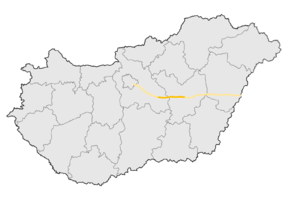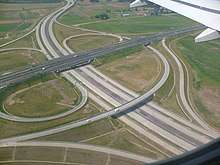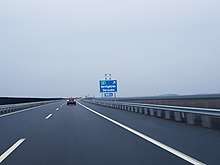M4 motorway (Hungary)
The M4 motorway is a Hungarian motorway, which will, upon completion, connect Budapest to Oradea and further Romanian cities. The route will travel in Hungary through Cegléd, Szolnok, Karcag, Püspökladány, Berettyóújfalu, and Nagykereki before reaching the Romanian border.
| |
|---|---|
| M4 autópálya | |
 | |
| Route information | |
| Part of | |
| Length | 66 km (41 mi) 233 km (145 mi) planned |
| Major junctions | |
| From | |
| To | |
| Location | |
| Counties | Pest, Jász-Nagykun-Szolnok, Hajdú-Bihar |
| Major cities | Budapest, Szolnok, Püspökladány |
| Highway system | |
History, plans and ongoing construction
The road's origins can be traced much further back in time - as far back as 1974, when the first section of the future motorway was opened. This section, from Albertirsa to Cegléd, served to bypass the older, congested Route 40, that passed through these towns. This was extended in 2005 to bypass Abony and Szolnok. The same year, the Törökszentmiklós bypass opened. On 6 July 2011, a bypass also opened at Kisújszállás. Most of these sections are only 1 lane per direction.
This route soon became congested, and the section going south of Szolnok was found to be unsuitable to upgrade to motorway status, so on 16 September 2013, a contract was signed regarding the new route of the motorway. This route would go northwards of Szolnok, crossing the Tisza rivers, and shortening the route of the motorway. Work will be done by Strabag, and the contract cost 10 billion Hungarian Forints. Since the motorway passes through an environmental area, protective fencing is to be installed on the new sections from Üllő towards Törökszentmiklós. Whilst this section was supposed to open by 2016, construction work was stopped on 30 June 2015, to investigate the companies who were building the road. Apparently, the project was submitted to the EU to be supported in 2013, but it never received approval. There was also the huge cost of the route - 4 Billion HUF per kilometer. The work on this section has restarted with a planned completion date of early 2022.

Preparatory work has started for the Törökszentmiklós-Kisújszállás-Karcag-Püspökladány-Berettyóújfalu section. This section envisaged an interchange with the M8 motorway, but the procurement procedure was abolished on 26 February 2014, leaving work halted on this section.
Sections finished or to be completed in 2020
The 10 km long Vecsés-Üllő bypass opened in 2004, completed up to motorway standards. This also helped to ease access into the Liszt Ferenc International Airport. However, this has left a gap between Albertirsa and Üllő, and the old road going through Monor soon became a bottleneck. This 29 kilometer long section of M4 was completed on February 7, 2020. In 2019, a section near Cegléd section was upgraded to a dual carriageway but so far it lacks the motorway status. An upgrade to that status is planned when the section between Cegléd and Abony is completed in the summer of 2020.
A 4-kilometer stretch of M4, near Berettyóújfalu, was inaugurated on December 20, 2018. This section serves to link the M35 motorway to Route 47.[1]

Works also started in 2016 on the Berettyóújfalu-Nagykereki section, which will connect to the Romanian A3 motorway, towards Oradea, Cluj, Târgu Mureș and Bucharest. However, just like the work on the A3 motorway in Romania, they were stopped due to funding issues. In 2018, Hungary received up to 265 million Euros from the EU Cohesion Funds specifically to complete this section of the M4 expressway. It is now expected to be complete by July 2020.
_Otszogletu_kek_tabla.svg.png)
